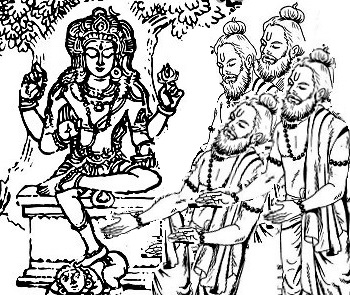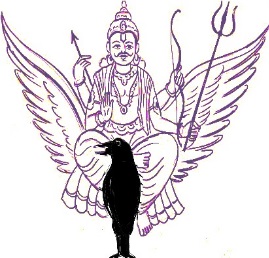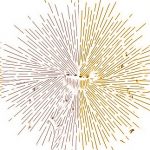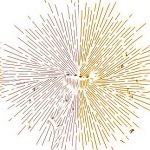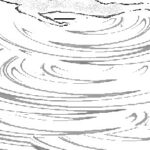Mangai Madam
Lord Yoganathaswamy cum
Lord Yoga Dakshinamurthi
temple
-Santhipriya-
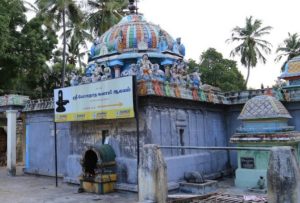
A rare temple for Lord Dakshinamurthi in the name of Lord Yoganathaswamy temple exists near Lord Aranyeswarar temple, in Nagapattinam district which has very interesting legend behind it. The temple where Lord Yoganathaswamy temple is situated is also known as Mangai Madam which is 3 kms from Thirunangur and 2 km from Thiruvenkadu towns both in Nagapattinam district. The specialty of the temple is that Lord Shiva appears in two postures namely as Lord Yoga Dakshinamurthi in yogic posture in one sanctorum outside the temple while as Yoganathaswamy in the form of self-manifested Shiva Ling in a sanctum inside the temple.
In most of the temples, Lord Dakshinamurthi can be seen enshrined either in standing or sitting posture, generally in the cut out blocks of the outer walls of the sanctum on the southern circumlocutory path. Only in very few temples one can see separate shine for him inside the same temple complex. In Lord Yoganathaswamy temple in Mangai Madam, we can see him seated in a small shrine within temple complex. However before reading the history of this temple, the features and aspects of Lord Yoga Dakshinamurthi is to be understood.
The manifestation of Lord Dakshinamurthi is interesting to read. In a Yagna performed by her father Thaksin, Goddess Parvathi was insulted and unable to bear it, she ended her life. Outraged by the death of his consort, Lord Shiva kept the dead body of Goddess Parvathi over his shoulder and ran around the universe in anger. To cool down the anger of Lord Shiva, quickly Lord Vishnu managed to cut the dead body of Goddess Parvathi in to several pieces so that they fall in different places. Perturbed by the act of Lord Vishnu, the anger of Lord Shiva waned away and to compose himself further, he returned to Himalayas and sat under a banyan tree facing southern side in yogic posture and the said posture turned into Lord Yoga Dakshinamurthi. Thus Lord Yoga Dakshinamurthi manifested from one of the five aspects of Lord Shiva namely the Agora (angry mood) posture. Dakshin means ‘south’. Therefore, Lord Yoga Dakshinamurthi, who manifested while Lord Shiva sat in yogic posture facing south came to be called Dakshin + Murthy(Lord) = Dakshinamurthi. That is the reason, why in the temples, Lord Dakshinamurthi is always seen enshrined only in the carved out blocks of walls on the southern side of the circumlocution passage. As Lord Shiva remained seated in Yogic posture, the greatest Rishis and Saints flocked there requesting him to grace them with the teachings on the highest aspects of Yoga and supreme wisdom.
One of the legend says that after emerging from Lord Brahma (the lord of creation), the four Sages called Brahmakumars (also stated to be sons of Lord Brahma) alias Sages Sanathkumaras began searching for a guru who could enlighten them on the philosophical aspects of wisdom, the secrets of Supreme truth and Yoga. They realized that since their father, Lord Brahma was drowned in the act of creation, Lord Vishnu in conjugal life, it would be futile exercise to reach out to them to get enlightened on those aspects and therefore Lord Shiva should be reached out. Lord Shiva knew that the Brahmakumars were searching suitable guru to get enlightenment on the aspects of the supreme truth and yoga, and if denied they would be disappointed and therefore he immediately transformed himself into a sixteen year old boy and sat under a Banyan tree awaiting for their arrival. The four Brahmakumars who were searching for Lord Shiva, unaware that the young sanyasi, glorious face with cool in appearance sitting under a banyan tree in yogic posture was Lord Shiva himself. They thought that the saint would be a great Yogi and therefore went to him seeking enlightenment on Yogic secrets, knowledge of Supreme truth and greatest wisdom. When they went near to him and stood with folded hands pleading thus, delighted with their humble submission, Lord Shiva, revealed to them his true form and agreed to enlighten them on all aspects as desired by them.
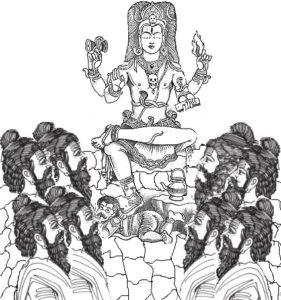
Lord Shiva in the form of Lord Yoga Dakshinamurthi preached them the inner secrets of Yoga, philosophy of wisdom and the Supreme truth through the medium of subtlest form of silence, abiding and inaudible to physical ear, which is the deepest form of meditation, and thus in silence he seeded the sermon into their mind. More and more doubts were raised by them and they were equally answered in the same speed of silence. Finally to enlighten them on the deeper secrets of Jeevathma and Paramatma in one word, Lord Yoga Dakshinamurthi displayed Chin Mudra with his right hand and that was the end of everything to calm down elated Brahmakumars who absorbed the entire knowledge and thereafter fell at the feet of the Lord Yoga and went away joyed in mind and heart at the fullest knowledge they gained.
It is believed that the place where the Brahmakumars were enlightened on the Supreme truth and wisdom is the present temple site of Lord Yoga Dakshinamurthi in Mangai Madam where one can see the statue of Lord Dakshinamurthi in Yogic posture with four Brahmakumars lying at the feet, the very same posture in which Lord Shiva manifested as Lord Yoga Dakshinamurthi in Himalayas at the end of his tapas there.
Lord Dakshinamurthi, an aspect of Lord Shiva is the universal teacher, immersed in self, personification of spiritual wisdom and embodiment of knowledge and destroyer of ones ignorance. He is accepted universally as the young and radiant Adi-Guru, imparting knowledge that liberates one from illusion. His teaching on Supreme truth is through the subtlest form of silence, abiding and inaudible to physical ear. Lord Dakshinamurthi always teaches through silence and not by oral preaching.
In Hindu philosophy four types of communications are mentioned which are verbal, non-verbal i.e. infusing doctrine through thoughts, visual imagery through inner eye within and finally transcendental through meditation. Lord Dakshinamurthi’s teaching in silence transcends speech and thoughts and therefore the Rishis eager to absorb the Guru’s teaching of greatest awareness, understanding and comprehension through divine speech are found sitting or standing at his feet.
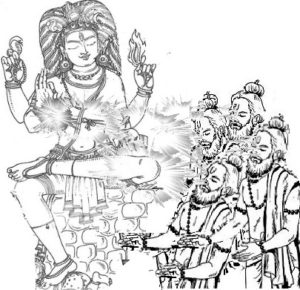
Within the temple complex, he is seated in a separate mini shrine, eyes closed in yogic posture. Once we enter the sanctum we can feel the presence of extraordinary tranquillity in the sanctum. Invisible to others, many Rishis often visit the shrine and stay at the feet of Lord Yoga Dakshinamurthi to grasp the knowledge he imparts in silence. The reason why Lord Yoga Dakshinamurthi preferred to sit in that isolated shrine in meant to not to get disturbed by the visitors while he imparts knowledge to the visiting Rishis. When you sit in meditation with closed eyes before Lord Yoga Dakshinamurthi, you will realize you are in vacuum and freed of illusion. You can freely offer prayers to him on any one of the day of the week, without any restriction. Although Lord Yoga Dakshinamurthi is called Guru for imparting knowledge, the Jupiter in Navagrahas who is also called Lord of Guru are altogether different divines. Therefore, the general belief that Lord Dakshinamurthi should be worshiped only on Thursday is incorrect as Thursday has no relevance with Lord Dakshinamurthi. The compatible colour for worship to Lord Jupiter (Lord Guru of Navagraha) is bright yellow while pure white is the compatible colour to Lord Dakshinamurthi.The Presiding Deity in the same temple, Lord Yoganathaswamy is in the form of self-manifested Shiva ling and his consort is called Goddess Yogambal seated in another sanctum. The Temple as well as the sanctum of Lord Yoganathaswamy is facing west but the entrance to the temple is located at the east. It is rare sight to find the prime deity enshrined facing west. During the Tamil months of Thai and Panguni (mid-January and mid-March) on specific days, the rays of the sun reportedly fall directly on the Shiva Ling and slowly vanish as the night begins. It is believed that the Sun God visit this shrine on those days to offer prayers to Lord Yoganathaswamy.
A big jack fruit is found grown in the North West corner of the temple. Do not know whether the tree is the sacred tree of the temple. Separate mini shrines are seen within the temple complex for Lord Vinayaga, Lord Muruga, Lord Bhairava, and Lord Surya besides shrines for Goddess Durgai and Goddess Mahalakshmi.
There are few interesting legends connected to this temple. The first legend is on Lord Shiva. Once a Demon called Maruththuvasuran arduously prayed Lord Shiva and got a powerful Soolam (a weapon like trident) from him. Pleased with his prayer, after Lord Shiva gave him powerful weapon Soolam, he began to terrorize celestial and give endless troubles to others killing them with the weapon he got from Lord Shiva. Unable to withstand his torture, agonized celestial went and complained to Lord Shiva pleading for protection from Maruththuvasuran’s torture. Even as the celestial were crying before Lord Shiva, hearing the atrocities of the Demon, Lord Shiva’s carrier vehicle divine Nandi angry ran and fought with him, but could not offer effective fight because of the special weapon he had and returned back profusely bleeding all over the body. Divine Nandi with nine wounds caused by Soolam, the special weapon held by Maruththuvasuran fell at the feet of Lord Swetharanyeswarar (who was Lord Shiva only in present temple of Mercury).
Lord Swetharanyeswarar shocked at the sight of profusely bleeding carrier vehicle divine Nandi, immediately took the ferocious form of Agoramurthi (one of the five forms or faces of Lord Shiva), not only attacked and killed the demon but also brought back the Soolam given by him. In order to get relieved of the Dosha of killing the Asura he took bath in a nearby river which was believed to have been created by Lord Yoga Dakshinamurthi himself and returned back to his seat which is the present temple in Thiruvenkadu (temple for planet Mercury). It is not difficult for the divines to simultaneously manifest in different forms in multi places. Therefore for the sake of welfare of the universe, Lord Shiva came to Mangai Madam and enshrined himself as Lord Yoganathaswamy as well as Lord Yoga Dakshinamurthi in two separate sanctums.
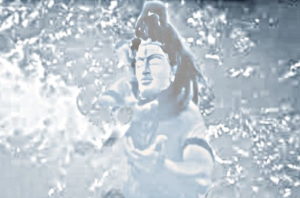
The second lore on the self-manifested Shiva Ling (Agoramurthi) is also very interesting to hear. Once while renovating the temple, when the temple authorities decided to relocate the Shiva Ling from its present sanctum and dug the land to pull out the Shiva Ling. Surprisingly when the base of the Shiva Ling could not be traced even after digging several meters, fearing that the operation could cause damage to the Shiva Ling they abandoned the idea of relocating the Shiva Ling. They then repaired and rebuilt the same sanctum leaving behind the Shiva ling remain in its original self-manifested spot.The third story related to Planet Guru of Navagrahas. Once due to a sin committed in Devaloga, planet Jupiter (Guru of Navagrahas) incurred Dosha and therefore came here and worshiped Lord Dakshinamurthi accepting him as his Guru to get rid of the sin besides getting enlightened on the supreme truth and wisdom. Thus like how Lord Muruga earned the fame as Guru of Guru after giving sermon to his own father Lord Shiva, in Mangai Madam too Lord Dakshinamurthi became Guru of Guru i.e. teacher to guru Bhagavan (planet Jupiter) when he not only removed his sins but also enlightened him with the extreme knowledge on wisdom in the form of his Guru (Master).
Fourth legend goes thus. Once when this temple site was under the rule of a Chola King (it is believed to be one of the decedents of King Saraboji, the Maratha King of Thanjavur), the Guru of Sadasiva Brahmendra Swamigal was in intense tapas. Due to years of intense tapas, his body became motionless allowing a big worm to settle with her family inside his ears. One day the King who was on inland tour of inspection, accidentally happened to notice the warm crawling in the ears of Guru of Sadasiva Brahmendra Swamigal. Freighted King immediately summoned his physician to remove the worm and clean the ears of the meditating Guru which disturbed the tapas after the King went away instructing the physician. Furious that his tapas has been disturbed, the Guru summoned the King show his displeasure and cursed the King.
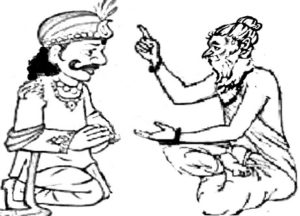
The King while explaining the facts fell at his feet seeking pardon, but Guru of Sadasiva Brahmendra Swamigal could not take back the curse and instead imposed a condition that if the King distributed free land and hand over the transfer deed of the land to 108 Brahmins living in that village, he would be absolved of the curse. Acting on his orders, the King distributed land and deed to 107 Brahmin families, but he could not find the 108th Brahmin to complete the donation. When the agonized King could not find the 108th Brahmin he prayed to Lord Shiva to help him. Pleased with the sincerity of the King, Lord Shiva himself came in disguise of a Brahmin and received the deed and land to absolve the curse and vanished thereafter. Both the King and the Guru of Sadasiva Brahmendra Swamigal were elated to witness the act of Lord Shiva.
It is believed that the land thus received by the Lord has been the present Lord Yoganathaswamy temple site of Mangai Madam. Though these lores are told by word of mouth stories, no evidence is available to substantiate them. However enough reasons to establish that the Jupiter temple (temple for planet Buddha) and this temple are interconnected in some way because of the act of Lord Swetharanyeswarar who destroyed the demon which inflicted injuries on his vehicle Divine Nandi are adduced by way of lores. It is also strange that for unknown reasons, the greatness of Lord Yoganathaswamy temple has not been widely spread either by the erstwhile rulers or the present Hindu Religious Endowment Department unlike the temple of Planet Buddha at Thiruvenkadu.
It is believed by some that the tomb on the banks of Manikkaiyaaru river belongs to Guru of Saint Sadasiva Brahmendra, who reportedly lived in the premises of the temple in Mangai Madam till he attained heavenly bliss (died). As wished by him he was reportedly buried on the banks of Manikkaiyaaru river after his death.
There are contradictory versions over who the guru of Saint Sadasiva Brahmendra was. According to few historical texts, it is stated that the 57th Pontiff of Kanchi Kamokoti Mutt, Sri Paramasivendra Saraswathi Swamigal, was Guru of Saint Sadasiva Brahmendra. Yet few other document states that one Shri. Nalli Adwari was disciple of Sri Paramasivendra Saraswathi Swamigal, the 57th Pontiff of Kanchi Kamokoti Mutt and Shri. Nalli Adwari’s another Guru was Saint Sadasiva Brahmendra. Therefore, it is not clear whether Saint Sadasiva Brahmendra was indeed the direct disciple of the 57th Pontiff of Kanchi Kamokoti Mutt Sri Paramasivendra Saraswathi Swamigal.

